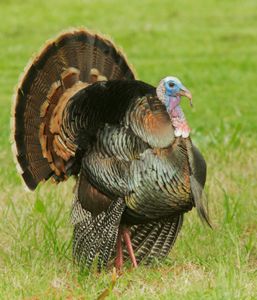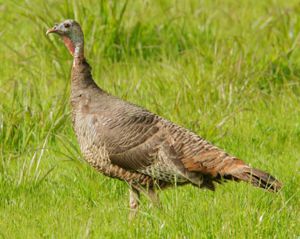BirdNote® - The Day of the Turkey
Air Date: Week of November 26, 2010
 |
The Day of the Turkey: Woe to the turkey that finds its fate on the dinner table. This week’s BirdNote®, narrated by Michael Stein, looks back at the history of both the farmyard and wild turkey.
Transcript
GELLERMAN: Coming up – a young Native American looks to the stars and helps land a man on the moon. That’s just ahead on Living on Earth.
GELLERMAN: It’s Living on Earth, I’m Bruce Gellerman.

A female Wild Turkey. (Photo: Tom Grey©)
[BIRD NOTE THEME]
GELLERMAN: In honor of the nation's favorite feast, we savor the turkey in this week's BirdNote© narrated by Michael Stein.
[TURKEYS GOBBLING]
STEIN: Any farmyard turkey still gobbling on the day after Thanksgiving is a fortunate bird. If that same turkey survives past Christmas dinner, it is a truly lucky fowl.
[TURKEYS GOBBLING]
STEIN: Farmyard turkeys were domesticated from a species called the Wild Turkey, originally native to the eastern and southwestern states and parts of Mexico. Wild Turkey numbers had plummeted by the early 20th Century, due to over-hunting and loss of habitat.
Yet fortune would smile on the Wild Turkey too. Game managers stepped in, re-introducing wild-caught birds to areas where turkeys had become scarce.
From the 1940s onward, there has been an upward trend in Wild Turkey numbers. In fact, turkeys now run wild in all of the lower 48 states and Hawaii, well beyond their original range.
[TURKEYS GOBBLING]
STEIN: But, back to the farmyard turkey. It is likely that the Mayans of southern Mexico had already domesticated turkeys as long as 2000 years ago.
Early Spanish explorers in the New World sailed off with domestic turkeys from Mexico, and soon turkeys were gobbling in farmyards over much of the world.

Will this turkey avoid the dinner plate this year? (Photo: Tom Grey©)
Early European colonists to America’s Atlantic seaboard actually brought domestic turkeys with them, completing the circle back to the New World.
It’s been a long and curious ride for the turkey, showing us both the upside — and downside — of life as a dinner table delicacy.
[TURKEYS GOBBLING]
GELLERMAN: That’s Michael Stein of BirdNote©. To see photos of wild turkeys, scratch a path to our website L-O-E dot org.
Links
Gobble of the domestic turkey provided by Martyn Stewart, Naturesound.org
BirdNote® “The Day of the Turkey” was written by Frances Wood and updated by Bob Sundstrom.
Living on Earth wants to hear from you!
Living on Earth
62 Calef Highway, Suite 212
Lee, NH 03861
Telephone: 617-287-4121
E-mail: comments@loe.org
Newsletter [Click here]
Donate to Living on Earth!
Living on Earth is an independent media program and relies entirely on contributions from listeners and institutions supporting public service. Please donate now to preserve an independent environmental voice.
NewsletterLiving on Earth offers a weekly delivery of the show's rundown to your mailbox. Sign up for our newsletter today!
 Sailors For The Sea: Be the change you want to sea.
Sailors For The Sea: Be the change you want to sea.
 The Grantham Foundation for the Protection of the Environment: Committed to protecting and improving the health of the global environment.
The Grantham Foundation for the Protection of the Environment: Committed to protecting and improving the health of the global environment.
 Contribute to Living on Earth and receive, as our gift to you, an archival print of one of Mark Seth Lender's extraordinary wildlife photographs. Follow the link to see Mark's current collection of photographs.
Contribute to Living on Earth and receive, as our gift to you, an archival print of one of Mark Seth Lender's extraordinary wildlife photographs. Follow the link to see Mark's current collection of photographs.
 Buy a signed copy of Mark Seth Lender's book Smeagull the Seagull & support Living on Earth
Buy a signed copy of Mark Seth Lender's book Smeagull the Seagull & support Living on Earth

